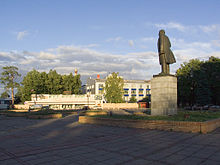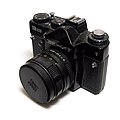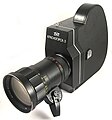Krasnogorsky zavod
|
OAO Krasnogorski zavod "SA Swerew"
|
|
|---|---|
| legal form | OAO |
| founding | February 1, 1942 |
| Seat | Krasnogorsk , Russia |
| management | Valery Zhigulich (General Director) |
| Branch | Cameras , optoelectronics , precision engineering , metal processing |
| Website | www.zenit-foto.ru |

The Krasnogorsky Zavod imeni SA Zvereva ( Russian . Красногорский завод им С. А. Зверева to German Krasnogorsker work "SA Zverev"; formerly Krasnogorski mechanitscheski zavod , russ Красногорский механический завод to German Krasnogorsker mechanics factory, usually. KMZ abbreviated) is a Russian Mechanical engineering company in Krasnogorsk near Moscow , which mainly produces optical technology .
Products
KMZ was best known for the cameras of the Zorki , Zenit and Krasnogorsk series , which were widely used in the Soviet Union and outside of it , of which several million were each produced. The company also has a large military optics department.
history
Foundation and the immediate post-war period
After the German attack on the Soviet Union in World War II , the Red Army had an acute need for optical precision instruments. The existing optical plants were either inaccessible due to the war, like LOMO in the blocked Leningrad , or overwhelmed with demand, like the FED plant , which had only recently been evacuated from Kharkiv to Berdsk . The KMZ plant was set up in 1942 on the site of a previously evacuated mechanical engineering company in a suburb of Moscow, which at that time was no longer directly threatened by the Wehrmacht . The company initially produced telescopic sights and binoculars as well as reconnaissance cameras .
After the end of the war, KMZ began producing lenses based on Zeiss models in 1945 , the main plant in Jena being captured by the Red Army and partly transported away as reparations . In the following years KMZ remained the main producer of lenses in the Soviet Union. In the post-war period, KMZ also began manufacturing the Zorki rangefinder camera , which was a direct replica of the Leica II and the Soviet FED , as well as Zeiss medium format cameras under the brand name Moskva. In addition to the originally purely military orientation of the company, the production of photographic equipment for end users began.
1950s and 1960s: creative years
From the mid-1950s, a period of increased research and development activity began at KMZ . One reason for this was the establishment of new optical factories in the Soviet Union which took over part of KMZ's lens production, such as Arsenal in Kiev from 1955, which freed up resources at KMZ. Another reason was the changed orientation of Soviet economic policy under Khrushchev , which provided for a stronger focus on production on consumer goods . In the period that followed, KMZ presented some interesting concept cameras that won international awards at trade fairs such as the 1958 World Exhibition in Brussels .
The Zorki series underwent considerable changes and developed from pure Leica replicas to a structurally independent camera series, from which a number of other interesting cameras were developed and e.g. T. were brought onto the market in small numbers. However, the most influential KMZ camera of the time was the Zenit SLR , which was based on the Zorki camera body and was first introduced in 1953. 1.2 million cameras of the first Zenit generation were produced until the series underwent a model change in 1967 and was equipped with the internationally popular M42 lens connection , among other things . In 1965 KMZ began producing film cameras , especially the widely used 16 mm Krasnogorsk camera . During this time there was also intensive cooperation between the military and civil departments at KMZ; an example of this was the horizon camera , which was developed from an older artillery camera and is still produced today in a modified form.
1970s and 1980s: serving the local market
At the end of the 1960s, development activity at KMZ in the field of camera technology slackened noticeably. One reason for this was the relatively low production figures. Since a large part of the resources was put into development work, the absolute production figures remained comparatively low, which under the conditions of the central administration economy was misunderstood as an indication of low productivity in the company as a whole. Another reason was possibly the renewed change in economic policy under Brezhnev , which envisaged a move away from consumer goods to capital goods and arms production.
Accordingly, in the 1970s, production at KMZ shifted towards producing relatively simple existing models in large quantities. There was still development activity going on, but there was a clear focus on mass production. The Zorki rangefinder cameras were produced in the form of a slightly modified model from 1956 in a total of 2.2 million copies until 1980, and the Krasnogorsk-3 film camera was produced almost unchanged from 1971 to 1989. There was more development work with the Zenit SLR cameras, for example with the installation of light meters , but here, too, the focus was on the production of robust, simple models and technical innovations such as automatic exposure were only introduced when they had been standard in the West for several years had become. In order to be able to meet the increased domestic demand in the Soviet Union, the Zenit production was outsourced to several camera companies . By the end of the 1980s, KMZ alone had produced over six million Zenit cameras, which at that time were, however, a technically very outdated camera model. The relative weight of the military department at KMZ, however, increased again due to the general orientation of the economy on arms production. KMZ also developed focal points in metal processing , optoelectronics and precision engineering , from which the company still lives today.
In 1989 KMZ employed around 32,000 people.
Since 1990: collapse and reconstruction
After the collapse of the Soviet Union in the wake of perestroika , production at KMZ largely came to a standstill. End customer products like the Zenit camera line continued to be produced for a few years, but competition on the international market was increasingly overwhelming. KMZ was still present at international trade fairs such as the Photokina or the PMA and also showed new products. The company now has a wide range of optical products, such as infrared riflescopes, that serve niche markets.
Company logo
Prior to 1949, KMZ's company logo featured a simple optical prism that factory workers quickly nicknamed "tombstone". In 1949 the logo was given its current form, which shows a prism and a beam of light refracted within it .
See also
literature
- Jean-Loup Princelle: The Authentic Guide to Russian and Soviet Cameras . Le Rêve, Ondreville-sur-Essonne 2004, ISBN 2-9522521-1-4 , p. a. Pp. 120-125.
Web links
- Company website (Russian)
- Camera Development Department Website (Russian)
- Full list of KMZ cameras (English)
Coordinates: 55 ° 49 ′ 44 ″ N , 37 ° 20 ′ 10 ″ E




